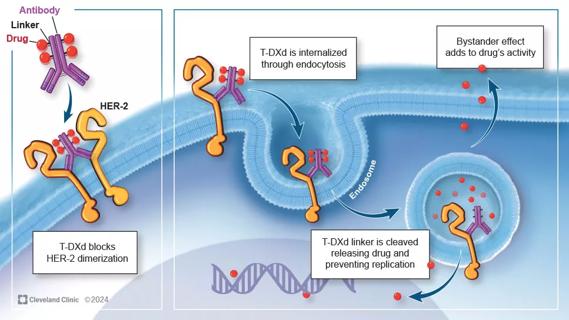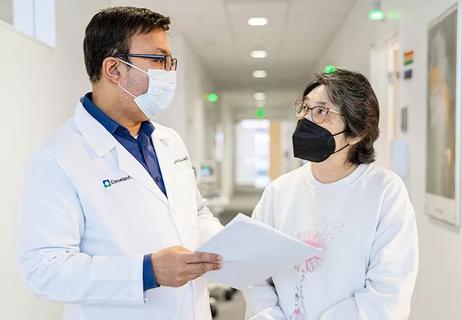Advertisement
Despite improvements in surgeries, medical therapies and radiation, the outlook for patients with glioblastoma (GBM) remains dismal. Patients live an average of just 15 months after being diagnosed with this aggressive brain tumor.
Advertisement
Cleveland Clinic is a non-profit academic medical center. Advertising on our site helps support our mission. We do not endorse non-Cleveland Clinic products or services. Policy
Glioblastoma’s bleak prognosis is due in large part to the heterogeneous nature of the tumor’s DNA. Tumors can often have unique genetic signatures, so what works for one patient may not work for another. Researchers are now exploring whether targeting treatment based on an individual tumor’s DNA could result in better outcomes for patients with GBM.
“We’d like to know the genetic driver of the patient’s tumor before we treat them,” says Manmeet Ahluwalia, MD, Director, Brain Metastasis Research Program, Cleveland Clinic. “The genomics of glioblastoma are very diverse and if we use targeted therapy that focuses on the genetic alterations of the tumor, the chances of success increase.”
Dr. Ahluwalia and investigators from several leading institutions are part of ALLELE, a new consortium to generate prospective clinical genomics and inform treatment decisions in patients with glioblastoma. The latest data from their work was presented at the 2018 American Society of Clinical Oncology meeting.
Patients enrolled in ALLELE undergo extensive genetic testing to determine the feasibility of genotyping their tumors in a timeframe that would support real-time use in clinical trials. So far, the researchers have enrolled 46 patients with GBM at five sites. The median time between surgery and biomarker analysis completion was 51 days, a clinically acceptable timeframe for patients with newly diagnosed GBM. The data will be made publicly available.
Of those 46 patients, 26 with MGMT-unmethylated GBM were subsequently enrolled in INSIGhT, a companion randomized multi-arm trial comparing the standard of care, temozolomide, versus three other experimental adjuvant treatments — CC-115, neratinib or abemaciclib. Predefined biomarker groups EGFR, PI3K and CDK-positive will be evaluated for their ability to predict outcome in each arm.
The first arm is the standard of care arm in which patients receive temozolomide orally on a daily dosing schedule approximately two to three hours before daily radiotherapy. Temozolomide is administered postradiation for up to six cycles (five days/cycle). Radiation occurs for a maximum of 49 days.
In the second arm, patients receive temozolomide orally on a daily dosing schedule approximately two to three hours before daily radiotherapy. Patients receive abemaciclib postradiation at a twice daily oral predetermined dose. Radiation occurs for a maximum of 49 days.
Patients in the third arm receive twice daily oral dosing of CC-115 along with daily radiation for a maximum of 49 days. In the fourth arm, patients receive temozolomide orally on a daily dosing schedule approximately two to three hours before daily radiotherapy. Patients receive neratinib postradiation at a daily oral predetermined dose. Radiation occurs for a maximum of 49 days.
Advertisement
INSIGhT, which is currently enrolling patients, will look at overall survival in the experimental arms compared with the standard temozolomide arm. It will also look at secondary incidence of treatment-emergent adverse events and progression-free survival.
Eligible patients must have evidence that their tumor MGMT promoter is unmethylated and must be immunohistochemically negative for IDH1 R132H mutations. Traditionally, the use of temozolomide is associated with just a one-month survival benefit in these patients. Hence researchers such as Dr. Ahluwalia are hopeful that the tumor-DNA tailored trial may result in improved outcomes. “We are hoping this precision medicine based approach is more likely to be successful compared with treating the whole group with one therapy in a heterogeneous tumor.”
Advertisement
Advertisement

First-of-its-kind research investigates the viability of standard screening to reduce the burden of late-stage cancer diagnoses

Study demonstrates ability to reduce patients’ reliance on phlebotomies to stabilize hematocrit levels

Findings highlight an association between obesity and an increased incidence of moderate-severe disease

Cleveland Clinic Cancer Institute takes multi-faceted approach to increasing clinical trial access

Key learnings from DESTINY trials

Gene editing technology offers promise for treating multiple myeloma and other hematologic malignancies, as well as solid tumors

Study of 401,576 patients reveals differences in cancer burdens as well as overall survival

Enfortumab plus pembrolizumab reduced risk of death by 53% compared with platinum-based chemotherapy